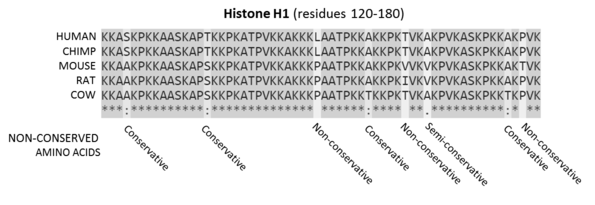Conservative replacement
This articleneeds additional citations forverification.(December 2017) |
Aconservative replacement(also called aconservative mutationor aconservative substitution) is anamino acid replacementin a protein that changes a givenamino acidto a different amino acid with similarbiochemical properties(e.g.charge,hydrophobicityandsize).[1][2]
Conversely, aradical replacement,orradical substitution,is an amino acid replacement that exchanges an initial amino acid by a final amino acid with different physicochemical properties.[1]
Description
[edit]
Sequences are theamino acidsfor residues 120-180 of the proteins. Residues that are conserved across all sequences are highlighted in grey. Below each site (i.e., position) of the protein sequence alignment is a key denotingconserved sites(*), sites with conservative replacements (:), sites with semi-conservative replacements (.), and sites withnon-conservative replacements( ). This key usesPAM250as a similarity measure.[3]
There are 20 naturally occurring amino acids, however some of these share similar characteristics. For example,leucineandisoleucineare bothaliphatic,branchedhydrophobes.Similarly,aspartic acidandglutamic acidare both small, negatively charged residues.
Although there are many ways to classify amino acids, they are often sorted into six main classes on the basis of their structure and the general chemical characteristics of their side chains (R groups).
| Class | Amino acids | 1-letter code |
|---|---|---|
| Aliphatic | Glycine,Alanine,Valine,Leucine,Isoleucine | G, A, V, L, I |
| Hydroxyl orsulfur/selenium-containing | Serine,Cysteine,Selenocysteine,Threonine,Methionine | S, C, U, T, M |
| Cyclic | Proline | P |
| Aromatic | Phenylalanine,Tyrosine,Tryptophan | F, Y, W |
| Basic | Histidine,Lysine,Arginine | H, K, R |
| Acidic and their amides | Aspartate,Glutamate,Asparagine,Glutamine | D, E, N, Q |
Physicochemical distances aim at quantifying the intra-class and inter-class dissimilarity between amino acids based on their measurable properties, and many such measures have been proposed in the literature.[4]Owing to their simplicity, two of the most commonly used measures are the ones of Grantham (1974)[5]and Miyata et al (1979).[6]A conservative replacement is therefore an exchange between two amino acids separated by a small physicochemical distance. Conversely, a radical replacement is an exchange between two amino acids separated by a large physicochemical distance.[4]
Impact on function
[edit]Conservative replacements in proteins often have a better effect on function than non-conservative replacements. The reduced effect of conservative replacements on function can also be seen in the occurrence of different replacements in nature. Non-conservative replacements between proteins are far more likely to be removed bynatural selectiondue to their deleterious effects.
See also
[edit]References
[edit]- ^abZhang, Jianzhi (2000-01-01). "Rates of Conservative and Radical Nonsynonymous Nucleotide Substitutions in Mammalian Nuclear Genes".Journal of Molecular Evolution.50(1): 56–68.Bibcode:2000JMolE..50...56Z.CiteSeerX10.1.1.584.896.doi:10.1007/s002399910007.ISSN0022-2844.PMID10654260.S2CID15248867.
- ^Dagan, Tal; Talmor, Yael; Graur, Dan (2002-07-01). "Ratios of Radical to Conservative Amino Acid Replacement are Affected by Mutational and Compositional Factors and May Not Be Indicative of Positive Darwinian Selection".Molecular Biology and Evolution.19(7): 1022–1025.doi:10.1093/oxfordjournals.molbev.a004161.ISSN0737-4038.PMID12082122.
- ^"Clustal FAQ #Symbols".Clustal.Archived fromthe originalon 24 October 2016.Retrieved8 December2014.
- ^abGraur, Dan (3 August 2015)."Radical and conservative amino-acid replacements".Judge Starling.Retrieved2018-03-11.
- ^Grantham, R. (1974-09-06). "Amino acid difference formula to help explain protein evolution".Science.185(4154): 862–864.Bibcode:1974Sci...185..862G.doi:10.1126/science.185.4154.862.ISSN0036-8075.PMID4843792.S2CID35388307.
- ^Miyata, Takashi; Miyazawa, Sanzo; Yasunaga, Teruo (1979-03-01). "Two types of amino acid substitutions in protein evolution".Journal of Molecular Evolution.12(3): 219–236.Bibcode:1979JMolE..12..219M.doi:10.1007/BF01732340.ISSN1432-1432.PMID439147.S2CID20978738.
